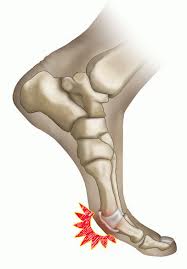Turf Toe (Metatarsophalangeal Joint Sprain)
Last Updated on October 23, 2023 by The SportsMD Editors
Turf toe is one of the more common injuries treated by sports medicine professionals. It is more often seen in athletes participating in the sport of soccer especially with the increase in the use of artificial turf. One of the downsides of artificial turf may be the increase in knee, ankle, and foot joint injuries.
What is turf toe?
Turf toe (Metatarsophalangeal Joint Sprain) is actually a sprain of the joint just below the big toe otherwise known as the first metatarsophalangeal (MTP) joint. The injuries to the joint can include damage to the ligaments as well as the joint capsule. The end result is pain with both extension and flexion of the big toe which translates into pain anytime the athlete tries to walk, jog, jump, or run.

What classifications of turf toe are there?
The severity of the injury is directly related to the amount of force causing the injury. Turf toe can range from a mild injury with only minor ligament damage to a chronic injury involving inflammation of the joint capsule and progressive cartilage formation and calcification of the head of the first metatarsal.
A mild injury would be considered a first degree sprain involving minor stretching of one or more ligaments in the joint. Although the ligament may have been stretched, the integrity of the ligament remains intact and the joint is stable.
An athlete with a mild injury may have point tenderness directly over the joint with associated mild swelling. The athlete may also complain of discomfort when the big toe is moved into flexion or extension and some pain with walking during toe-off phase.
A moderate injury would be considered a second degree sprain and involves partial tearing of the ligament and possibly tearing of the joint capsule. This athlete would have moderate pain and swelling and marked pain upon walking. Partial tearing of one or more ligaments and the joint capsule would make the MTP joint unstable.
An athlete with this degree of injury should be referred to a sports medicine professional for proper diagnosis and follow-up. The sports medicine professional may also recommend an x-ray to rule out possible associated fractures.
The most severe turf toe injury is a third degree sprain with a complete rupture of the ligament(s) and/or joint capsule. These injuries are significant. The athlete suspected of a third degree joint sprain should also be referred to a sports medicine professional for follow-up.
How is turf toe diagnosed?
Turf toe can be easily diagnosed with a thorough medical history and evaluation including range of motion and joint stability tests.
Who gets turf toe?
Athletes in all kinds of sports can sustain a sprain to their first metatarsophalangeal joint. However, the highest incidence of turf toe is seen in the sport of soccer because the constant use of the foot places it at risk for injury. Along with injury from direct impact with the ground or an opponent, athletes can also injure their toe from constant stopping and starting jamming the toe into the end of the shoe.
For the same reason as above, all athletes regularly practicing or competing on artificial turf are also at risk for these types of injuries. Sports played on artificial turf may include soccer, football, and lacrosse.
Sprains to the big toe may also be seen in beach volleyball players because of the shifting and unstable surface of the sand. These athletes may incur injuries from hyperflexion injuries whereas the athletes competing on turf usually sustain injuries from hyperextension of the big toe.
What are the causes?
Turf toe can be caused by either one traumatic injury or from repetitive injuries that continue to aggravate the original injury. Most turf toe injuries are caused by a hyperextension injury when the toe hits an unyielding surface (i.e., opponent, artificial turf, or hard ground) forcing the toe beyond its normal range of motion.
What can I do to prevent it?
Some shoe companies have begun to address this problem by adding stiffer material to the forefoot of their turf shoes. Athletes may also consider purchasing flat insoles with fortified soles under the forefoot for the same purpose.
What is the immediate treatment for Turf Toe (Setatarsophalangeal joint Sprain) ?
Immediate treatment for a mild turf toe includes using the P.R.I.C.E. principle of Protection, Rest, Ice, Compression, and Elevation. These principles are used to reduce pain and swelling during the first two days post-injuries.
Protection would include protecting the MTP from excessive movement. This can be done through either taping or through the use of a stiff-soled shoe. Depending on the severity of the pain, non-weight bearing may be recommended with the use of crutches.
As the pain reduces over time, the athlete can begin gentle range of motion exercises through pain-free extension and flexion. Care must be taken not to push the athlete through painful movements as this may aggravate the initial injury.
A fun exercise to strengthen the muscles that flex and extend the big toe is picking up marbles. Spread small marbles out on the floor. While the athlete is sitting in a chair, have the athlete pick up the marbles with his/her toes and place the marbles into a bowl placed nearby. This is a great way to work the intrinsic muscles of the foot without the athlete realizing it.
Athletes suspected of second or third degree injuries should be immediately removed from the activity, splinted, and referred to a sports medicine professional for x-rays and follow-up care.
KT Taping for Turf Toe
When Can I Return to Play?
Athletes can return to play when they have been released by their sports medicine professional and when they have a pain-free range of motion (both flexion and extension) and full-strength equal to the uninjured foot.
Get a Telehealth Appointment or Second Opinion With a World-Renowned Orthopedic Doctor
 Telehealth appointments or Second Opinions with a top orthopedic doctor is a way to learn about what’s causing your pain and getting a treatment plan. SportsMD’s Telehealth and Second Opinion Service gives you the same level of orthopedic care provided to top professional athletes! All from the comfort of your home.. Learn more via SportsMD’s Telemedicine and Second Opinion Service.
Telehealth appointments or Second Opinions with a top orthopedic doctor is a way to learn about what’s causing your pain and getting a treatment plan. SportsMD’s Telehealth and Second Opinion Service gives you the same level of orthopedic care provided to top professional athletes! All from the comfort of your home.. Learn more via SportsMD’s Telemedicine and Second Opinion Service.
𝗪𝗵𝗮𝘁 𝗶𝘀 𝘁𝘂𝗿𝗳 𝘁𝗼𝗲? 𝗛𝗼𝘄 𝗱𝗼𝗲𝘀 𝘁𝗵𝗲 𝗶𝗻𝗷𝘂𝗿𝘆 𝗵𝗮𝗽𝗽𝗲𝗻?
After #Titans wide receiver Treylon Burks suffered a turf toe injury in Week 4, Dr. Ronald Derr joined @AtoZSports to discuss all things turf toe on a DocTalk segment.
👀 https://t.co/p5mGi3bsTb pic.twitter.com/KKIVA95sCK
— Bone and Joint Institute of Tennessee (@boneandjointtn) October 11, 2022
Questions and Answers
When discussing turf toe or any medical condition with a healthcare provider, it’s essential to ask questions to gain a better understanding of your condition and potential treatment options. Here are some questions you can ask, along with potential answers:
- What is turf toe?
- Turf toe is a sprain or injury to the ligaments around the base of the big toe. It’s often caused by hyperextension of the toe, like when playing sports on artificial turf.
- What caused my turf toe injury?
- Turf toe is often related to activities that involve bending the big toe excessively, such as running, jumping, or sudden stops and turns.
- How was turf toe diagnosed in my case?
- Diagnosis typically involves a physical examination, medical history, and may include imaging studies like X-rays or MRI.
- What symptoms should I expect with turf toe?
- Symptoms may include pain, swelling, limited range of motion in the big toe, and discomfort during activities.
- Is treatment necessary for turf toe?
- Treatment depends on the severity of symptoms and the extent of the injury. Some cases may respond to conservative measures, while others may require more extensive interventions.
- What are the treatment options for turf toe?
- Treatment options include rest, ice, compression, elevation (RICE), immobilization with a splint or brace, physical therapy, and, in rare cases, surgical repair.
- How long will the recovery process take, and what can I expect during this time?
- Recovery time varies based on the treatment approach and the extent of the injury. It can range from a few weeks to several months. Physical therapy may be needed for rehabilitation.
- What restrictions or limitations should I expect during the recovery period?
- Your doctor will explain any limitations on activities to protect the injured toe during healing.
- What are the potential complications associated with treatment and recovery?
- Complications are generally minimal. Surgery may carry risks, such as infection or stiffness. Your doctor can provide more information.
- What is the long-term outlook for turf toe?
- With appropriate treatment and rehabilitation, many individuals experience a good recovery and can return to their normal activities without persistent symptoms.
- Do I need a follow-up appointment, and when should it be scheduled?
- Establish a plan for post-treatment follow-up appointments to monitor your progress and make any necessary adjustments to your care.
Always consult with your healthcare provider for personalized answers to these questions, and feel free to ask additional questions or seek clarification on any points you don’t fully understand. Effective communication with your doctor is crucial for your understanding and overall care.
References
Anderson, M.K., Parr, G.P. & Hall, S. (2009). Foundations of Athletic Training: Prevention, Assessment, and Management. (4th Ed.). Lippincott Williams and Wilkins: Baltimore, MD.
Arnheim, D.D. & Prentice, W.E. (2000). Principles of Athletic Training. (10th Ed.). McGraw Hill: Boston, MA.
Bahr, R. & Maehlum, S. (2004). Clinical Guide to Sports Injuries. Human Kinetics: Champaign, IL.
Brukner, P. & Khan, K. (2002). Clinical Sports Medicine (2nd Ed.). McGraw Hill: Boston, MA.

